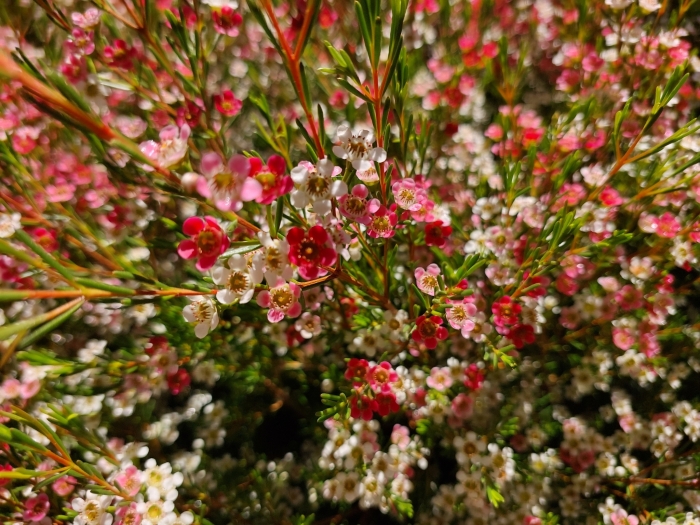Geraldton Waxflower
(Chamelaucium uncinatum)
Geraldton Waxflower (Chamelaucium uncinatum)
/
/

© Shanon_Johannes
CC BY 4.0
Image By:
© Shanon_Johannes
Recorded By:
Copyright:
CC BY 4.0
Copyright Notice:
Photo by: © Shanon_Johannes | License Type: CC BY 4.0 | License URL: http://creativecommons.org/licenses/by/4.0/ | Uploader: shanonjohannes | Publisher: iNaturalist |

























Estimated Native Range
Summary
Chamelaucium uncinatum, commonly known as Geraldton waxflower, is an evergreen shrub native to the sandy plains and coastal heathlands of Western Australia. It typically grows to a height of 2 to 13 feet (0.6 to 4 meters) and features needle-like leaves. The plant is renowned for its profuse blooming of white or pink flowers from late winter to spring (June to November in the Southern Hemisphere), which are highly ornamental and prized for their waxy texture and long vase life. The flowers are particularly showy, making it a favorite in ornamental gardens.
Geraldton waxflower is valued for its aromatic foliage, drought tolerance, and low maintenance requirements. It is widely cultivated in home gardens for its beautiful flowers and used extensively in the cut flower industry. This shrub is also utilized as a rootstock for grafting other species due to its hardiness. In cultivation, it requires well-drained sandy soil, full sun exposure, and minimal water once established. While it is generally disease-resistant, it can be susceptible to root rot if overwatered or planted in poorly drained soils.CC BY-SA 4.0
Geraldton waxflower is valued for its aromatic foliage, drought tolerance, and low maintenance requirements. It is widely cultivated in home gardens for its beautiful flowers and used extensively in the cut flower industry. This shrub is also utilized as a rootstock for grafting other species due to its hardiness. In cultivation, it requires well-drained sandy soil, full sun exposure, and minimal water once established. While it is generally disease-resistant, it can be susceptible to root rot if overwatered or planted in poorly drained soils.CC BY-SA 4.0
Plant Description
- Plant Type: Shrub
- Height: 3-5 feet
- Width: 3-5 feet
- Growth Rate: Moderate
- Flower Color: Pink, Red, White
- Flowering Season: Spring, Winter
- Leaf Retention: Evergreen
Growth Requirements
- Sun: Full Sun
- Water: Medium
- Drainage: Medium
Common Uses
Border Plant, Drought Tolerant, Fragrant, Low Maintenance, Potted Plant, Showy Flowers, Street Planting
Natural Habitat
Native to the sandy plains and coastal heathlands of Western Australia
Other Names
Common Names: Waxflower
Scientific Names: , Chamelaucium uncinatum, Chamelaucium affine, Chamelaucium uncinatum var. leptophyllum, Darwinia uncinata,
GBIF Accepted Name: